A Las Vegas Bathroom and 9 Other Unexpected Places to See the Berlin Wall
Twenty five years ago, the Berlin Wall came crumbling down. Today, segments can be found in over 140 memorials worldwide
/https://tf-cmsv2-smithsonianmag-media.s3.amazonaws.com/filer/17/01/1701984f-683b-4a7c-9982-d705aba39206/42-63258188.jpg)
When the Berlin Wall fell on November 9, 1989, an instrument of nearly three decades of separation seemed to disappear from the streets of Berlin in a matter of days. The wall, erected in 1961, had taken a mere couple of weeks to build, and its destruction was equally swift—within a few years, nearly every trace of it had vanished from the city. An open border replaced the burdensome concrete slabs as a new symbol of Berlin; for the city's inhabitants, the wall was nothing more than an embarrassment, a blight, a shackle to a past of separation, violence and grief. Large sections—mostly the grim, grey eastern side—were simply crushed up and repurposed, to be used for road construction.
Fifteen years after the wall came down, Berlin began protecting what remained of it as a memorial to the once-divided city. Today, a .8-mile stretch of the structure, known as the East Side Gallery, still stands. The East Side Gallery touts itself as the largest open-air gallery in the world, featuring over 100 murals and paintings, which were added to the traditionally dour eastern side of the wall after 1989.
Outside of Berlin, the wall was seen through different eyes. The first request for a portion of the wall—from a Bavarian businessman—came only a day after its initial destruction. To many, pieces of the wall, especially those from the western side covered with graffiti, were potent symbols of democracy's victory. Needing foreign currency to fund their new government, the transitional German Democratic Republic decided on January 4, 1990, to support the "commercial use of complete segments" of the wall. Pieces were parceled out, sometimes as gifts, sometimes as acquisitions, to sites all across the world. Today, more than 140 places around the globe boast a portion of the Berlin Wall.
Around the world, the Berlin Wall pops up in some entirely expected locations: you can see it outside of the United Nations, where it was erected in autumn of 2001, as part of a gift from the city of Berlin to the former Secretary General of the U.N. Kofi Annan. A portion of the wall is also visible outside of the European Parliament, in Brussels—another gift from Berlin to the world. Germany was less generous to their French neighbors, however; when Paris attempted to receive a portion of the wall, it cost them 300,000 marks for three pieces (that same year, a private collector purchased a single segment for 3,000 marks).
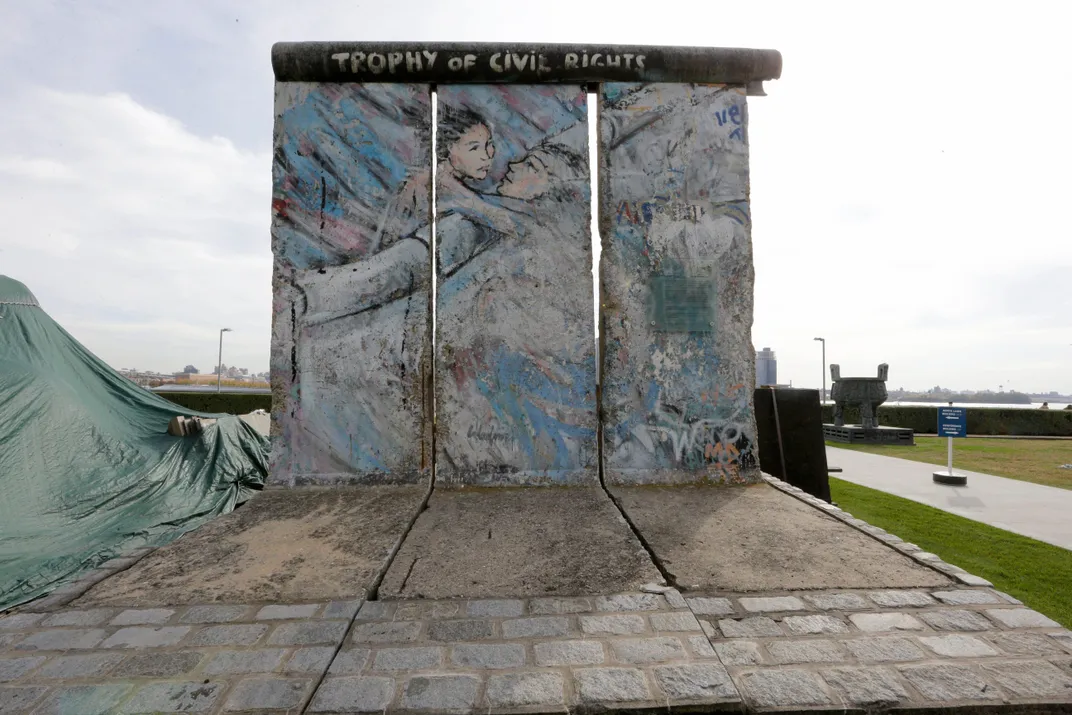
But portions of the wall can be found in entirely unexpected places too—from public restrooms to private gardens—transformed from symbols of oppression into backdrops for sculptures, paintings and even urinals.
1) Wilshire Boulevard, Los Angeles
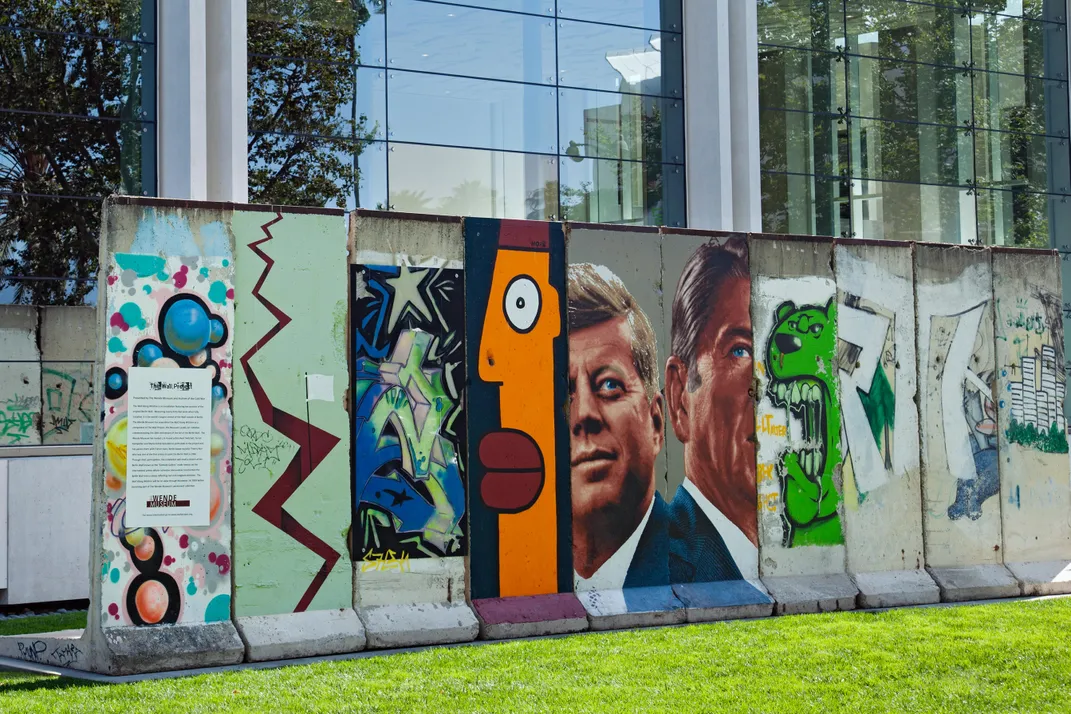
Outside of Berlin, the longest stretch of the Berlin Wall is located in Los Angeles. On Wilshire Boulevard, across from the Los Angeles County Museum of Art, stand ten panels from the wall, stretching almost 40 feet down the street. The Wende Museum, a Culver City, California-based institution that focuses on the Cold War, brought the panels to L.A. in 2009, as part of a larger program meant to mark the 20th anniversary of the wall's collapse. The museum chose Wilshire Boulevard for its symbolic importance as a main east-west street in Los Angeles. The artwork seen on the wall, for the most part, isn't original—the Wende Museum commissioned four artists to paint five of the segments in public view. One of the artists, French-born, Berlin-based Thierry Noir, was one of the first artists to paint the Berlin Wall in the early 1980s.
2) Up-Park Camp; Kingston, Jamaica
After breaking the world record for the 100-meter dash at the 2009 Athletic World Championships, Jamaican sprinter Usain Bolt received an incredibly unique gift: a nearly 12-foot-tall portion of the Berlin Wall, complete with a mural of Bolt breaking the record, painted in vibrant green and yellow. A gift from the governing Mayor of Berlin, Klaus Wowereit, the 2.7-ton segment was transported to Jamaica by boat in 2009, a journey that took three weeks. Today, the segment is on display at the Up-Park Camp in Kingston, the current headquarters of the Jamaican military.
3) Teltow, Germany
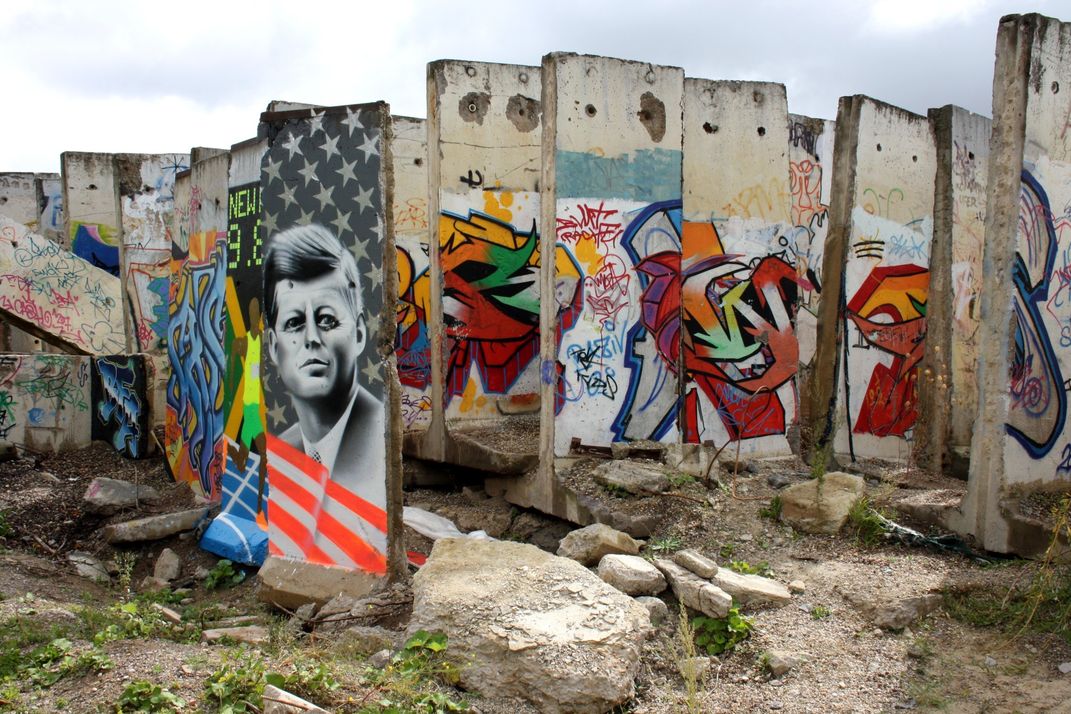
In the early 1990s, a concrete plant bought sections of the Berlin Wall with the intention of storing them on site and perhaps eventually using them as materials. The segments sat on the company's property in Teltow (a town 11 miles outside of Berlin) for years, until the company had accumulated around 200 different pieces. Inspired by the East Side Gallery, Teltow officials invited artists to paint the barren concrete slabs, hoping to create a public, open-air art installation similar to one in Berlin. Public interest, however, fizzled, and the segments were purchased (many still unpainted) by Elmar Prost, director of a building material company in Teltow. Prost decided to use the wall segments to start his own private art enterprise, inviting artists to paint the slabs and then selling them to private and public buyers around the world. Of the 164 segments Prost originally bought, 40 remain in the Teltow storage area. Interested parties can still apply to paint, and sell, portions of the wall.
4) German Embassy; Santiago, Chile
In early 1990, students from the Universidad de Chile had an idea: they would obtain a section of the Berlin wall, install it in Chile's capital city of Santiago, and auction the segment off as a fundraiser. Their wish was granted when Berlin gave Universidad de Chile students studying then studying in the city a piece of the wall for free. They were able to transport the segment back to Chile via boat free of charge, thanks to the Ultramar shipping agency. When the piece of the wall arrived in the port of Valparaiso, the Germany Embassy offered to buy it from the students, donating money toward their project in the name of the Federal Republic of Germany. The piece was eventually unveiled outside of the German Embassy in Santiago on October 3, 1991.
The Berlin Wall and Chile are intertwined in another way, too: After the wall came down, the East German political leader Erich Honecker—who had been one of the most vocal proponents of the wall in 1961—sought refuge in the Chilean Embassy in Moscow (he was wanted in Germany on manslaughter charges, because he had given orders telling East German guards to shoot and kill anyone trying to flee to the West). Honecker stayed at the Embassy for seven months, where he was granted sanctuary by Ambassador Clodomiro Almeydam, who had sought refuge in East Germany during the reign of the Chilean dictator Pinochet. In 1993, Honecker was brought back to Berlin, where judges ruled that he was too ill to stand trial. He lived in exile in Santiago with his wife and daughter's family until his death, from liver cancer, in May of 1994.
5) Main Street Station, Las Vegas
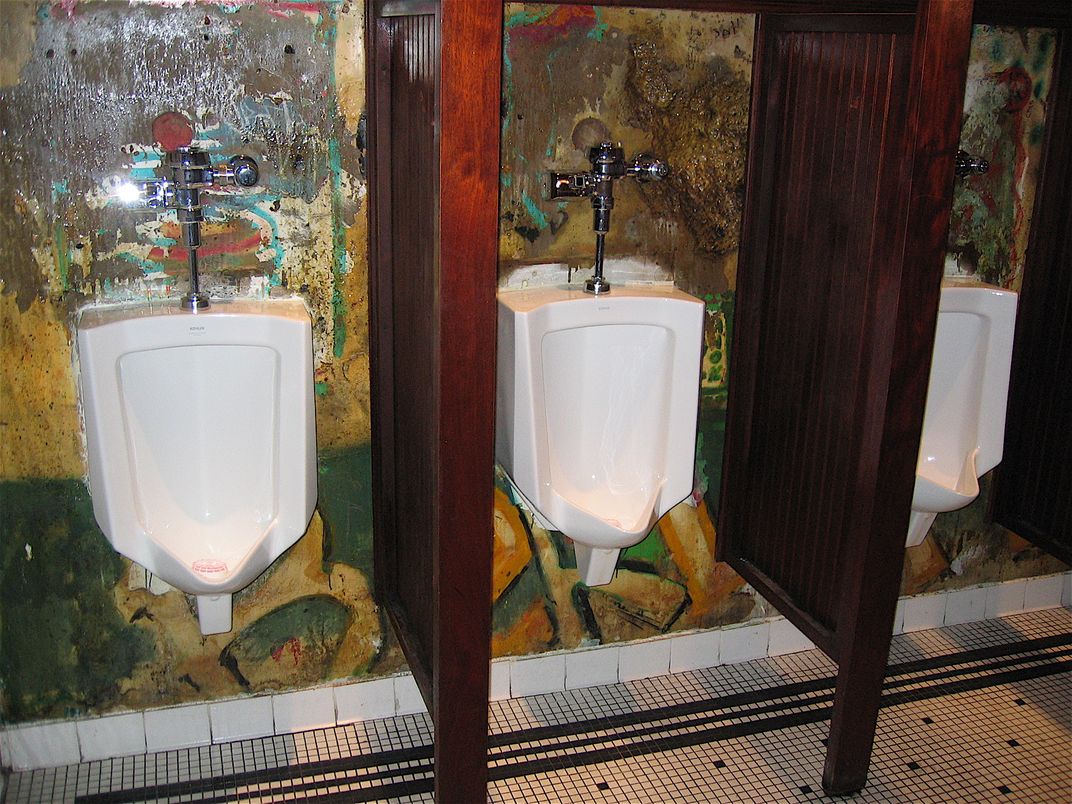
In the Main Street Station Casino in Las Vegas, men can do something they would have been severely punished for doing in Berlin pre-1989: pee on the Berlin Wall. In reality, a glass barrier prevents any urine from splashing on the historic wall, but the men's room at the Main Street Station Casino does have a section of the Berlin Wall, upon which three urinals are mounted. Boyd Gaming Corporation, who currently owns Main Street, told CNN that the Wall was already in the bathroom when the company bought the property. Female patrons aren't completely out of luck—according to CNN, they can request that a security guard escort them into the bathroom to look at the Wall.
6) Schengen, Luxembourg
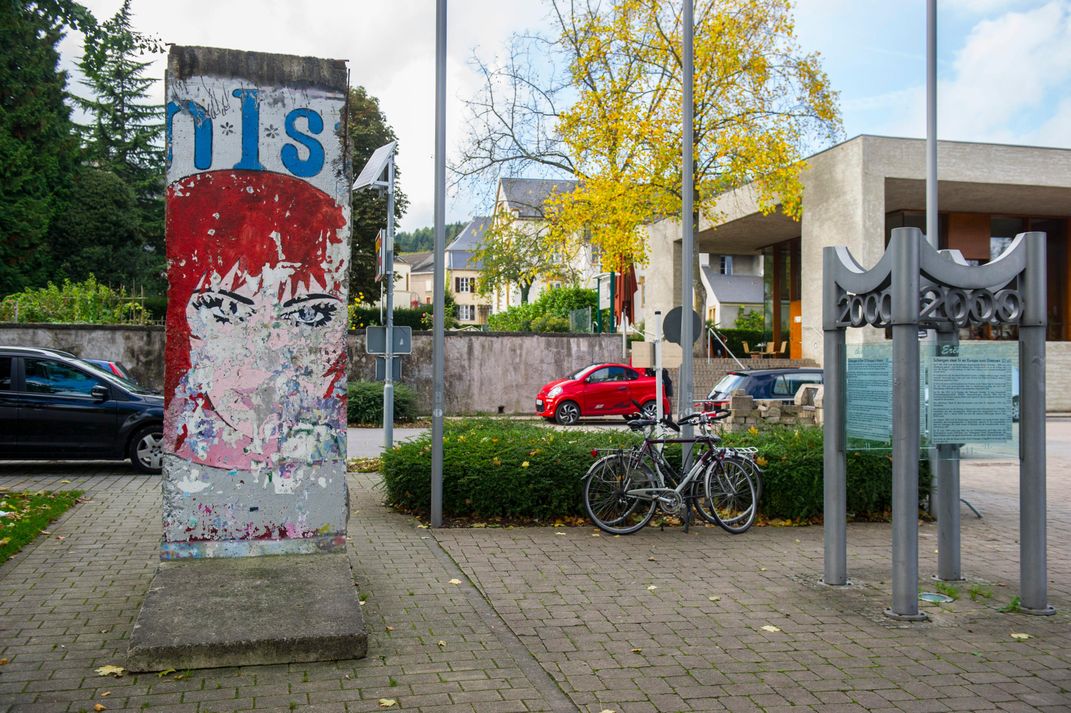
While Berlin in the 1980s symbolized a divided Europe, Schengen—a tiny village of 20,000 in Luxembourg—represented a more unified Europe. The 1985 Schengen Agreement made it easier for citizens of Belgium, France, Germany, Luxembourg and the Netherlands to travel freely between those countries. On the 25th anniversary of the Schengen Agreement, a section of the wall was unveiled in the small town, outside of their European Museum. Alongside the wall is a peace pole, with the inscription "May peace prevail on Earth" written in 12 languages.
7) Fátima, Portugal
Fátima, about 62 miles north of Lisbon, is one of Portugal's most important—and most heavily visited—pilgrimage sites. In 1917, the Virgin Mary is said to have appeared to three shepherd children, telling them stories about hell, the Second World War and the collapse of Communism. Many considered the rise and fall of the Berlin Wall to be proof of the Fátima prophecy.
Pilgrims brought pieces of the wall to Fátima as gifts, and in 1991, a 2.6-ton segment made its way to the site. The chunk was blessed by Pope John Paul II, making it the only portion of the Berlin Wall to receive a pope's blessing.
8) Seoul, South Korea
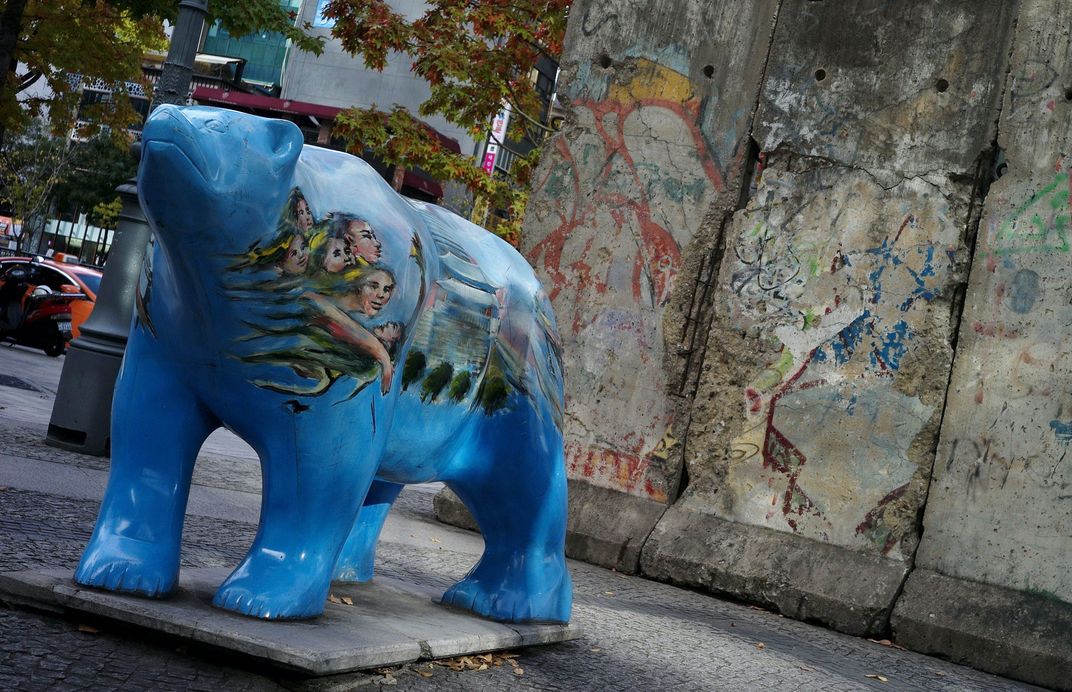
In South Korea's capital, in the middle of what is known as "Berlin Square," a blue bear stands watch over three sections of the Berlin Wall, which were brought to the city in 2005. Given to the city as a gift from Berlin, in the spirit of friendship and connection, the wall remains a powerful symbol of separation—and the potential for peaceful reunification—in South Korea. The slabs of wall retain some original graffiti, sprayed on the wall's western side, while the bear is traditionally a symbol of Berlin.
9) Sosnóvka, Poland
To Ludwik Wasecki, a Polish-born dentist and art collector, the fall of the Berlin Wall represented an artistic opportunity. On his own, Wasecki created two whimsical replicas of the wall made entirely of wood and papier-mâché (one features a fork bursting through the wall, the other, a gold car). A Berlin-based reporter took interest in his work, connecting him with Rainer Hildebrandt, director of the Checkpoint Charlie Museum. Hildebrandt worked to get Wasecki a true portion of the Berlin Wall, which Wasecki hoped to make into another art installation. With help from Hildebrandt and others at the museum, Wasecki was able to bring seven pieces of the wall back to a meadow outside of the town of Sosnóvka, located right outside of his birthplace, Wrocław.
Over the years, Wasecki continued to amass a collection of segments of the wall, all of which found their home in Sosnóvka. Today, 42 chunks stand in a field outside of the Polish town—representing the largest collection of wall pieces outside of Berlin.
10) Franklin D. Roosevelt Library; Hyde Park, New York, and the National Churchill Museum; Fulton, Missouri
President Franklin Delano Roosevelt, who guided the United States through the Second World War, never lived to see a wall divide Berlin into East and West. His British counterpart, Sir Winston Churchill, lived for four years after the wall was erected, but died long before it fell. Still, the legacy of the two men has become connected with that of the wall, thanks to two pieces of art created by Churchill's granddaughter, sculptor Edwina Sandys. On the grounds of the National Churchill Museum, in Fulton, Missouri, stands an installation titled "Breakthrough," which features eight panels from the Berlin Wall with cutouts of human figures. The second piece, "BreakFree," can be seen at the FDR Library in Hyde Park, located steps away from the house where Roosevelt was born. "BreakFree" features two figures—the missing pieces formed by the cutouts of the wall segments displayed in Fulton—standing side-by-side. Sandys revealed "Breakthrough" in 1990, while "BreakFree" found its place in Hyde Park in 1994.
/https://tf-cmsv2-smithsonianmag-media.s3.amazonaws.com/accounts/headshot/natasha-geiling-240.jpg)
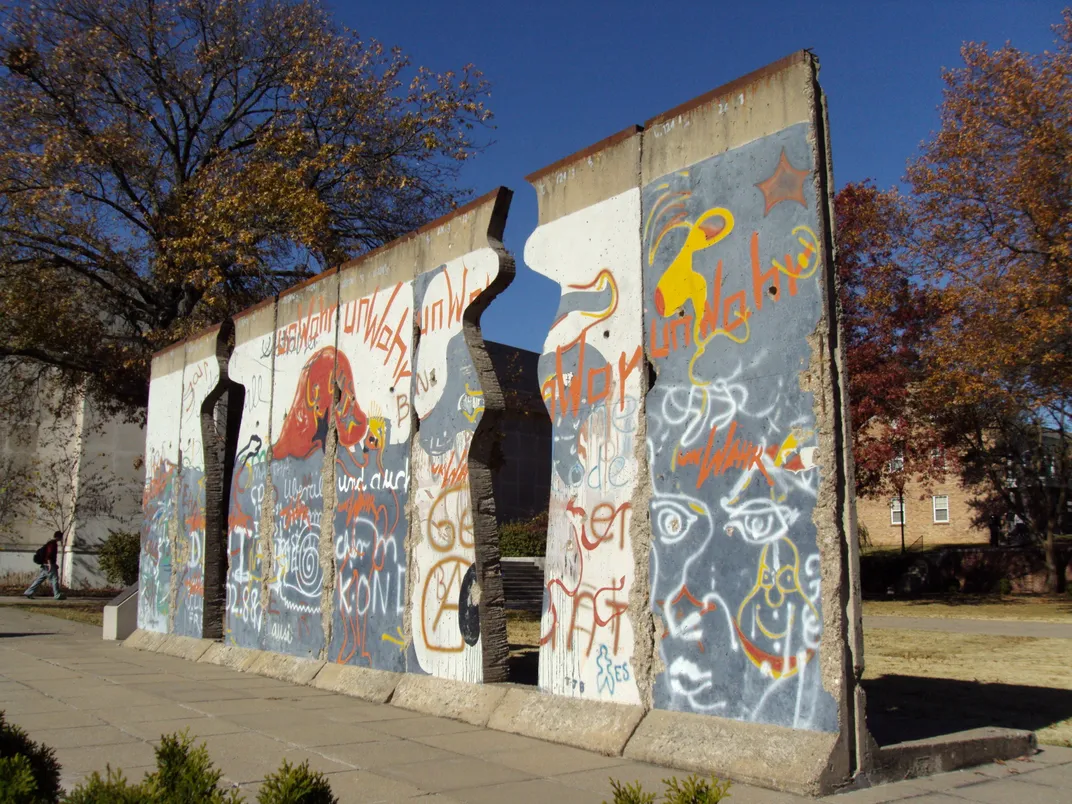
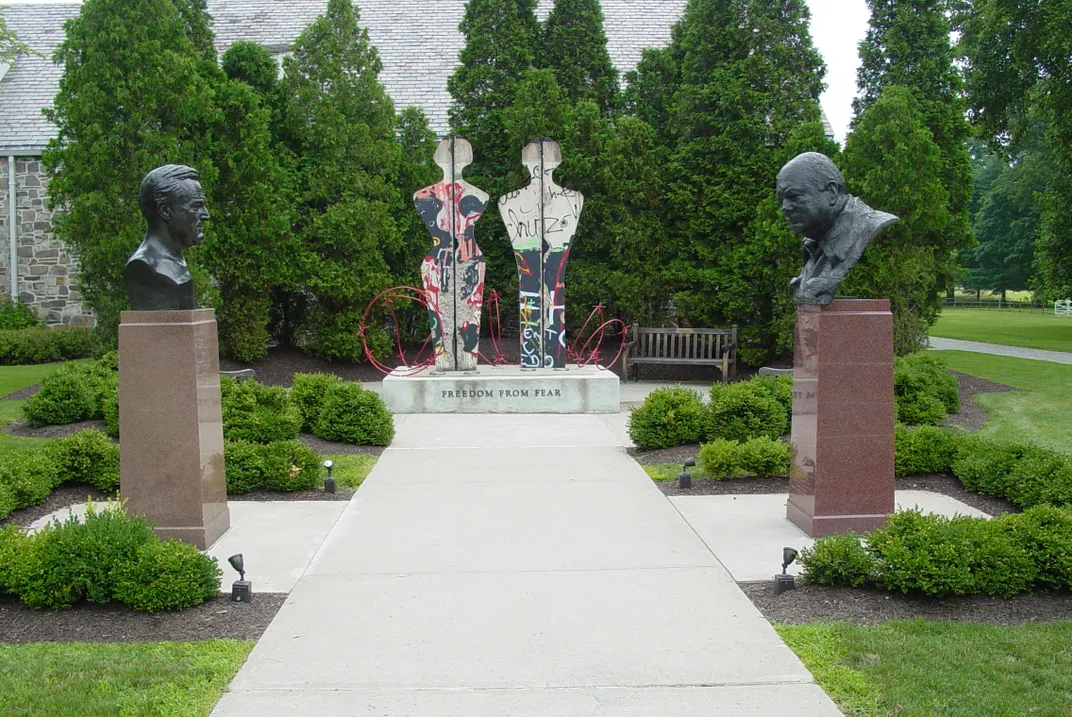
/https://tf-cmsv2-smithsonianmag-media.s3.amazonaws.com/accounts/headshot/natasha-geiling-240.jpg)